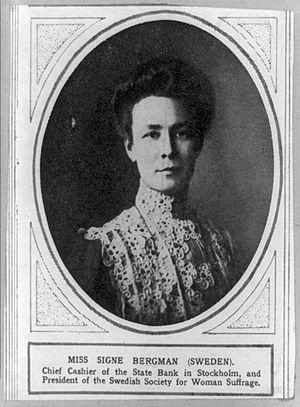Signe Bergman facts for kids
Quick facts for kids
Signe Bergman
|
|
|---|---|

Signe Bergman, chairman for the Swedish Society for Woman Suffrage in 1914–1917.
|
|
| Born | 1869 |
| Died | 1960 (aged 90–91) |
| Occupation | Clerk |
| Known for | Women's rights activist |
Signe Wilhelmina Ulrika Bergman (born April 10, 1869 – died 1960) was a Swedish activist who worked for women's rights. She was a very important leader in the movement that fought for women to have the right to vote, which is called women's suffrage.
Signe Bergman was the chairperson of the National Association for Women's Suffrage (LKPR) from 1914 to 1917. She also represented Sweden at the International Woman Suffrage Alliance from 1909 to 1920. She helped organize a big international meeting for women's suffrage in 1911. She was also the editor of the LKPR's newspaper, Rösträtt för kvinnor (Women's suffrage).
Contents
Early Life and Career
Signe Bergman was born in Stockholm, Sweden. Her family was involved in government work. She received a good education at home, even though it wasn't a formal school.
She spent some years living in Great Britain. There, she worked at an institute run by her cousin, Martina Bergman-Österberg. She also helped a researcher at the British Museum. After returning to Sweden, she worked as a clerk at a bank called Sveriges allmänna hypoteksbank.
Fighting for Women's Right to Vote
Signe Bergman became one of the most important leaders in the Swedish movement for women's voting rights. In 1902, two ideas about women's suffrage were brought up in the Swedish Parliament.
One idea came from Hjalmar Hammarskjöld, who suggested that married men should get two votes. He thought they could vote for their wives too. This idea made many women's rights activists angry.
The other idea came from Carl Lindhagen, who suggested that women should have the right to vote. Women's rights activists supported Lindhagen's idea.
Starting the Suffrage Movement
Because of these ideas, a group called Föreningen för Kvinnans Politiska Rösträtt (FKPR) was started on June 4, 1902. This group began in Stockholm but quickly became a national organization called the National Association for Women's Suffrage (LKPR) the next year.
Signe Bergman was very active in this movement:
- From 1906 to 1914, she was a member of the main committee for the Stockholm branch of the LKPR.
- In 1907, she joined the central committee for the entire national organization.
- From 1914 to 1917, she served as the chairman of the LKPR.
She also edited the organization's newspaper. From 1909 to 1920, she was part of the International Woman Suffrage Alliance. She represented Sweden at many international meetings about women's voting rights.
Why She Joined the Fight
In an interview in 1911, Signe Bergman explained why she became involved in the fight for women's suffrage:
It was Carl Lindhagen's second idea on women's suffrage which was made fun of and simply ignored. He fought for us – shouldn't women like me stand up?
This shows her strong belief that women should fight for their own rights.
A Strong Leader
Even though Signe Bergman was formally chairman from 1914 to 1917, many people saw her as the main leader of the Swedish suffrage movement from the very beginning. Newspapers often made cartoons of her, calling her the "Suffrage General."
She was known for being strong and effective. People saw her as the main force behind the organization's actions, fundraising, and meetings. She was also the main organizer of the Sixth Conference of the International Woman Suffrage Alliance in 1911. This meeting was a huge success for the LKPR.
Challenges and Resignation
In 1911, the LKPR's chairman, Lydia Wahlström, resigned. Officially, it was for health reasons. However, the LKPR had a rule to stay politically neutral. They decided to start boycotting political parties that were against women's suffrage. This meant they were no longer truly neutral, because only the conservative party was against women's suffrage. Since Wahlström was a conservative, she resigned.
This caused some disagreements between different groups of women in the LKPR. Signe Bergman was seen as the clear choice for the next chairman. However, because she was known for her socialist views, some thought Anna Whitlock, a former chairman, would be a less controversial choice. So, Signe Bergman did not formally become chairman until 1914, after these disagreements had calmed down.
In 1917, most parties in the parliament supported women's suffrage. But a proposal for women's suffrage was still voted down. Because of this, Signe Bergman resigned from her position as chairman.
See also
 In Spanish: Signe Bergman para niños
In Spanish: Signe Bergman para niños

